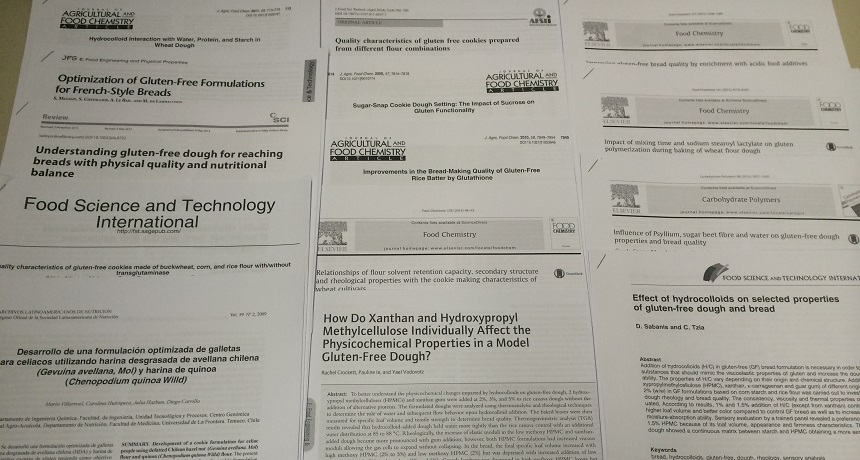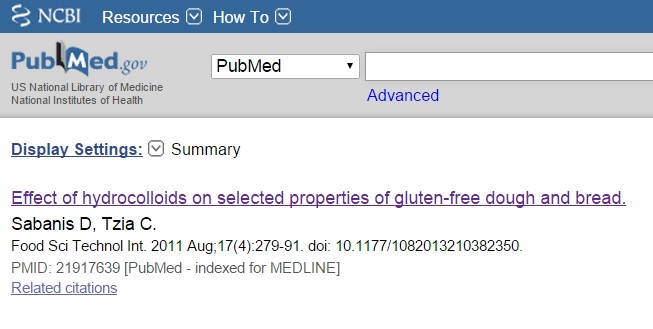Cookie Science 12: Heading to the library
To design my next experiment, I need new ideas. To find them, I’ll be reading scientific papers

I need new ideas to help me design my next experiment. Reading scientific papers should help. Here’s a selection of my readings. But I’m still not sure what to do about the one in Spanish at the bottom left.
B. Brookshire/SSP
This article is one of a series of Experiments meant to teach students about how science is done, from generating a hypothesis to designing an experiment to analyzing the results with statistics. You can repeat the steps here and compare your results — or use this as inspiration to design your own experiment.
I’m on a quest to make a great gluten-free chocolate chip cookie. I suspected that just substituting gluten-free flour for normal baking flour would not yield a very good cookie. And my first experiment showed that I was right. So now I need to figure out what might make my gluten-free cookie taste more like a normal cookie. But to find out how to tweak my recipe, I need to head to the library.
I’m off to hunt down the scientific literature. This does not mean reading novels (though I do love novels). The scientific literature is a global library. It consists of millions of research papers written by legions of different scientists. Most of these papers describe one or more experiments. Some of these papers, I suspect, could guide my design of a new hypothesis.
As I read scientific papers, I can learn if other scientists have attempted what I have already tried. Reading about how other scientific experiments were done also can give me clues about how I might come up with a yummier recipe. I might even get ideas about how to interpret my results.
Warning: Scientific papers can be difficult to understand. They tend to use a lot of long words, long sentences and lots of numbers. It can be a challenge to understand the details of what the authors did and why. When I first started reading scientific papers, I looked up words as I went along. I took lots of notes about details I learned along the way. It sometimes could take me an entire day just to read five pages! But with each new paper, I found I understood more of the terms. After a while, it became pretty easy to spot the things I needed that would help me conduct my own experiments.
Which ‘library’ to visit
There are several places on the Internet to hunt down scientific papers. The U.S. National Library of Medicine, part of the National Institutes of Health (NIH), runs a site called Pubmed.gov. If researchers got money from NIH to conduct their work, a link to their published findings must be posted on Pubmed. That makes it a good site for finding the titles of papers on how the human body functions. Since I’m interested in how people digest gluten and what gluten’s effects on the body are, this makes a good starting “library” for me.
But keep in mind that Pubmed links to the full scientific papers, but they may not be available without purchase (there are buttons that show when they will be available for free). This site lists the title of a paper and posts the abstract of its findings. (Abstracts are short blurbs that describe what the authors reported in their papers.) It can provide a good clue to which paper I might want to read in full.
Getting a scientific paper often can cost money. Fortunately, colleges and universities often buy access to many journals. So if you need one or more papers and don’t have the $35 to spend on each, you might want to visit a university library. You might also try finding the author’s email address. Many scientists will email a copy of one of their papers if you ask them nicely. That’s how I got many of the papers I needed.
I could look at arXiv.org if I wanted to find scientific papers in fields such as math, physics and computer science. This site, run by Cornell University, contains links to papers that have been published and a great many that have not yet appeared in any journal.
I also search for papers on Google Scholar. The site scans scientific journals and sites for articles and books that match search terms.
How to search
Here, as elsewhere on the Internet, coming up with the right search terms can be important. For example, search for “gluten” in Pubmed and you’ll get a list of than 10,000 article titles. Try searching for “gluten baking” and the list drops to just 120 article titles — a much more manageable number. Searching “gluten cookie” turned up only 14 articles. But with such a short list, I risk missing the title to a paper I will really want to read.
To find the papers I wanted, I conducted many different searches. I used many combinations of terms. I know that gluten effects how elastic dough is, so I search “gluten elasticity.” I know that some studies will only study gluten-free baking, so I ran a search for that as well.
After each search, I scanned the titles of the articles carefully. I read abstracts from those whose titles seemed most promising. This helped me narrow down the list of papers that I might want to read in full.

To find those papers, I next focused on its citation. That told me who wrote the paper, the name of the scientific journal in which it was published and the date it was published.
With this information in hand, I now head to the website for each journal with a promising paper. I’ll look on that website for the words “peer reviewed” somewhere. That term means that a few scientists have looked at each article before it was published and concluded that it did not appear to contain sloppy science or large mistakes.
If a paper is peer-reviewed and reading it could prove useful, I now will track down a copy of the whole paper.
How to read a paper
Once I have those papers in hand, the real work begins. I take a careful look at the text and images. Each scientific paper is divided into sections. Knowing what’s in each can make finding the data I seek easier.
Here’s how a typical research paper is organized:
1. It starts with the Introduction: This section explains why the authors chose to run the experiments described in the paper.
2. Materials and Methods: This section lays out exactly how the scientists conducted their experiments. Ideally, this section should be so detailed that another scientist could read it and repeat its experiments in exactly the same way.
3. Results: This is where the scientists present their findings. They often have many graphs and tables. This is also the section where scientists show their statistics — how they have analyzed the data and whether they have found any important differences between test groups or conditions.
4. Discussion: Here, the scientists try to interpret their results. They also might offer an educated guess as to why their results could prove useful.
5. References: The ideas for most scientific experiments come from earlier experiments and ideas, usually by others. In the references section, the scientists list citations to all of the scientific papers they used to help design their hypotheses and interpret their results.
All of these sections can prove helpful and worth reading. Even the references can point to other papers that I might need.
Now, I’ve got a pile of reading to do for Cookie Science. But all of this reading will help me figure out how to revise my hypothesis.
Follow Eureka! Lab on Twitter
Power Words
abstract (in science) A short summary of a scientific paper, a poster or a scientist’s talk. Abstracts are useful to determine whether delving into the details of the whole scientific paper will yield the information you seek.
citation A short list of abbreviated details that can help someone find a published or unpublished piece of work, such as a scientific paper, article or video. In scientific papers, citations usually contain 1) the first initials and last names of the scientists who did the experiments (if there are many authors, only the first one or two may show up, followed by et al— meaning “and others”), 2) the full title of the paper or talk, 3) the name of the scientific journal, book or event in which the information has or will be published (and if it’s long, the journal’s name also may be abbreviated) and 4) the date that the research was or will be published. (An example: E.D. Coffel and R.M. Horton. Climate change and the impact of extreme temperatures on aviation. American Meteorological Society annual meeting, Phoenix, January 8, 2015.)
control A part of an experiment where nothing changes. The control is essential to scientific experiments. It shows that any new effect must be due to only the part of the test that a researcher has altered. For example, if scientists were testing different types of fertilizer in a garden, they would want one section of to remain unfertilized, as the control. Its area would show how plants in this garden grow under normal conditions. And that give scientists something against which they can compare their experimental data.
gluten A pair of proteins — gliadin and glutenin — joined together and found in wheat, rye, spelt and barley. The bound proteins give bread, cake and cookie doughs their elasticity and chewiness. Some people may not be able to comfortably tolerate gluten, however, because of a gluten allergy or celiac disease.
hypothesis A proposed explanation for a phenomenon. In science, a hypothesis is an idea that hasn’t yet been rigorously tested.
peer review (in science) A process in which scientists in a field carefully read and critique the work of their peers before it is published in a scientific journal. Peer review helps to prevent sloppy science and bad mistakes from being published.
statistics The practice or science of collecting and analyzing numerical data in large quantities and interpreting their meaning. Much of this work involves reducing errors that might be attributable to random variation. A professional who works in this field is called a statistician.
statistical analysis Mathematical processes that allow a scientists to make conclusions from a set of data.
statistical significance In research, a result is significant (from a statistical point of view) if the likelihood that an observed difference between two or more conditions would not be due to chance. Obtaining a result that is statistically significant means there is a very high likelihood that any difference that is measured was not the result of random accidents.
variable (in mathematics) A letter used in a mathematical expression that may take on more than one different value. (in experiments) A factor that can be changed, especially one allowed to change in a scientific experiment. For instance, when measuring how much insecticide it might take to kill a fly, researchers might change the dose or the age at which the insect is exposed. Both the dose and age would be variables in this experiment.